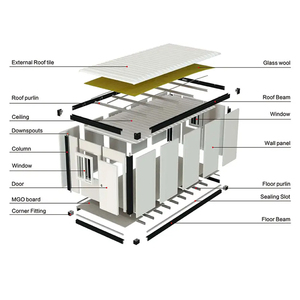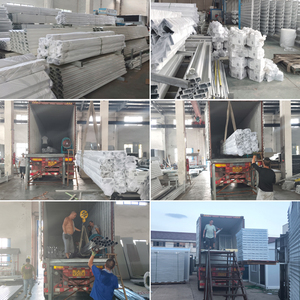(7737 products available)






















































































































































































































A modular container gym is a fitness center constructed from shipping containers. These containers are designed for transporting goods over long distances and can be used to create gyms. Modular container gyms are built using one or more shipping containers that can be stacked on top of each other or placed side by side to create a larger space. They are increasingly being used to create portable and cost-effective gyms. Here are the different types:
Single-Container Gym:
This is a basic type of modular container gym. It is created from a single shipping container. As such, the space inside the gym is limited. Usually, this type of gym has enough space for a few essential fitness equipment pieces, such as weights, a bench press, and a squat rack. Due to the limited space, single-container gyms are most commonly used in outdoor or home fitness areas. They can also be ideal for personal use or small training sessions. Additionally, they are an excellent option for fitness enthusiasts who want to avoid the hassle and expense of a traditional gym.
Double-Container Gym:
This type of gym is built from two shipping containers. They are stacked on top of each other to create more space. Double-container gyms have more room than single-container gyms. As such, they accommodate various fitness equipment. They are also highly versatile and can be used for various fitness activities, including strength training, cardio workouts, and yoga sessions. Moreover, they are suitable for personal use or small training studios. Double-container gyms are also commonly used for pop-up gyms in events and festivals.
Custom-Designed Container Gyms:
This type of gym can be built from multiple shipping containers. They can also be combined to create a larger space. Ideally, custom-designed container gyms are designed to meet specific requirements and preferences. They also have the most space and can be designed to include locker rooms, showers, office space, and a reception area. Additionally, they can be fitted with specialized equipment, such as climbing walls or martial arts training areas. This type of gym is ideal for commercial fitness centers. It can accommodate large groups of people. Moreover, it is suitable for franchises that require consistency across multiple locations.
Modular container gyms have unique features that make them an excellent choice for fitness enthusiasts. Here are their key features and functions:
Portability
Portability is vital for a modular container gym because it allows the gym to be moved to different locations easily. This is great for people who travel a lot or work in different places. Portability also means the gym can be set up in various places, making fitness accessible to more people. For example, it can be placed near someone's home or in a community area. Additionally, portable gyms take up less space and are more convenient to move than traditional gyms, which are large and fixed in one location. Overall, portability increases flexibility and convenience for users and operators.
Durability
Durability is crucial for a modular gym because it ensures the gym can withstand different weather conditions and continue to work well for many years. This is essential for people who want to invest in a long-lasting fitness space. A durable gym also means the equipment inside it will be protected from damage. Moreover, a durable gym needs less fixing and replacing, saving money over time.
Space Efficiency
Space efficiency is essential for a modular container gym because it ensures that every inch of space is used well. This means that even though the gym is small, there is still room for all essential fitness equipment like weights, treadmills, and space for exercise. When space is used efficiently, people can do many different workouts without the gym feeling cramped.
Customization
Customization is vital for a modular container gym because it allows each gym to be tailored to meet different people's or communities' specific fitness needs. This means the gym can include the right equipment for different exercise programs, whether lifting weights, yoga, or cardio. Customization also lets the gym be set up to suit different spaces, whether small or large. Additionally, a customized gym is more appealing and useful to people because it offers what they want.
Cost-effective
Cost-effective solutions are essential for a modular container gym because they make creating and owning a gym cheaper. Using shipping containers as gyms costs less than building traditional gyms from scratch. This means more people can afford to purchase or set up a gym. A cost-effective gym also requires less maintenance and replacement, which helps save money over time.
The global container gym market is growing rapidly because of the different benefits of modular container fitness centers. Here are some common application scenarios for modular container gyms:
Temporary and Remote Locations
Modular container gyms are ideal for temporary and remote sites where traditional fitness facilities may be challenging to establish. For instance, they can be deployed to construction sites, mining camps, disaster relief zones, and military bases. Their portability and ability to be set up quickly in a container format offer a convenient solution for onsite fitness and wellness programs. This promotes the physical and mental well-being of individuals in such environments, improving their productivity and overall health, as they have access to fitness facilities.
Urban and Space-Constrained Areas
These gyms also fit well in urban areas with limited space or where traditional gym infrastructures are hard to come by. For example, they can be installed in repurposed containers in parking lots, rooftops, and other underutilized spaces. This provides a flexible and cost-effective solution for urban communities to access fitness facilities without the high overhead costs and long construction times of traditional gyms.
Personal and Private Use
Additionally, modular container fitness centers can also function as a private gym for personal use. Individuals who prefer to work out alone or with a few others can convert a shipping container into a gym and place it in their homes. This eliminates the need to pay for gym space and time used, as well as the inconveniences of going to a gym.
Supplementary Spaces
Modular container gyms can also serve as a fitness center supplement to existing facilities. They offer an economical and practical solution for fitness centers looking to expand their space or services on a temporary or permanent basis. The flexibility and modularity of these gyms allow for easy scaling and stacking of multiple containers to create additional workout areas, storage for equipment, and locker rooms.
When sourcing for modular gym containers, it is important to choose a design that will meet the needs of the target market. Here are some factors to consider when choosing a gym container:
Size and Space
Consider the available space and the number of people who will be using the gym. A small space will be ideal for individual workouts, while larger spaces will cater to more people. Additionally, consider the type of workouts preferred, as this will determine the ideal size. For example, yoga and pilates require less space, while high-intensity workouts need more space.
Location and Climate
The climate of the intended location will influence the design of the modular container gym. If the climate is warm, go for a design with adequate ventilation. However, if it is cold, choose a design with proper insulation. Additionally, consider whether the location is permanent or temporary when choosing a gym.
Equipment Needs
Different gyms offer unique workout experiences. Therefore, it is important to select a gym that will accommodate the essential equipment. For example, a gym for strength training needs more space than one for cardio. Additionally, it is important to consider the layout of the gym, as this will influence the flow of workouts.
Cost and Budget
The cost of the gym container will vary depending on its size, design, and additional features. Therefore, it is important to consider the available budget to get a gym that is affordable. Additionally, compare the costs associated with different types, as some require more maintenance than others.
Customization and Additional Features
Some gym containers offer customization options that allow one to add unique features. Therefore, it is important to consider the additional features that will enhance the gym experience. For example, air conditioning, flooring, mirrors, and lighting. Analyzing the available options will help in choosing a gym that meets all the requirements.
Q1: Are modular container gyms customizable?
A1: Yes, modular container gyms are highly customizable. Gyms can be fitted with various equipment, storage solutions, and changing rooms. Exterior customization is also possible, like branding and signage.
Q2: What are the basic equipment of a modular gym?
A2: Basic modular gym equipment includes cardio machines like treadmills and stationary bikes; strength training equipment such as free weights and resistance bands; and fitness accessories like yoga mats and foam rollers.
Q3: What maintenance does a modular container gym require?
A3: Regular cleaning of gym equipment and containers is necessary. It is also important to conduct routine inspections and address minor issues to prevent them from escalating.
Q4: How long does it take to set up a modular container gym?
A4: The setup time varies depending on the number of containers and level of modular gym customization. A basic setup can take a few weeks, while complex configurations may require several weeks or months.
Q5: Can someone operate a modular gym without prior experience?
A5: It is possible to run a gym without prior experience, but it is advisable to acquire the necessary knowledge. This includes understanding gym operations, fitness industry standards, and effective management practices.